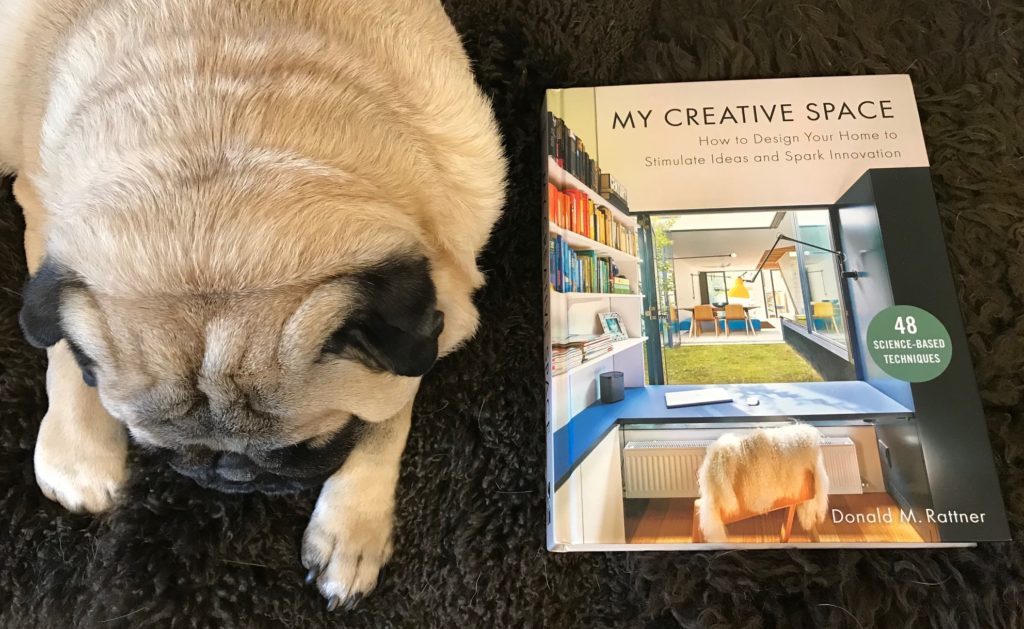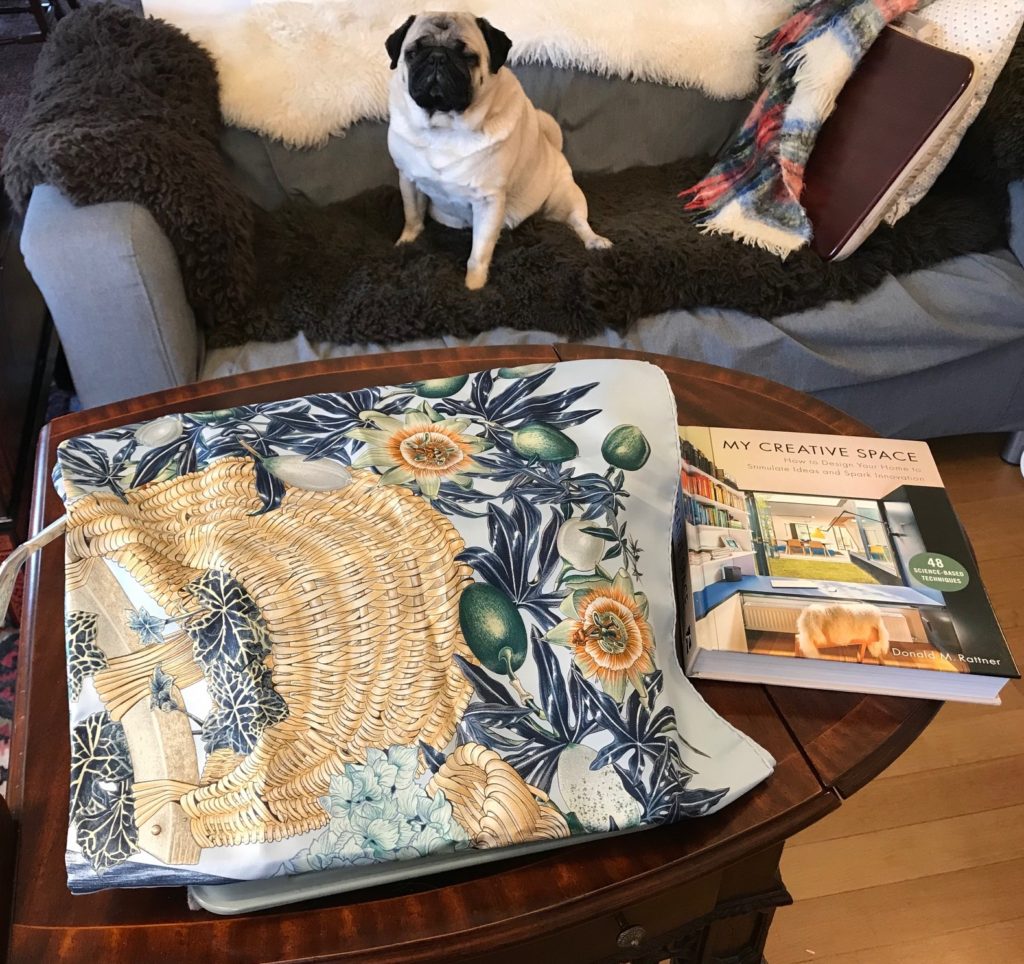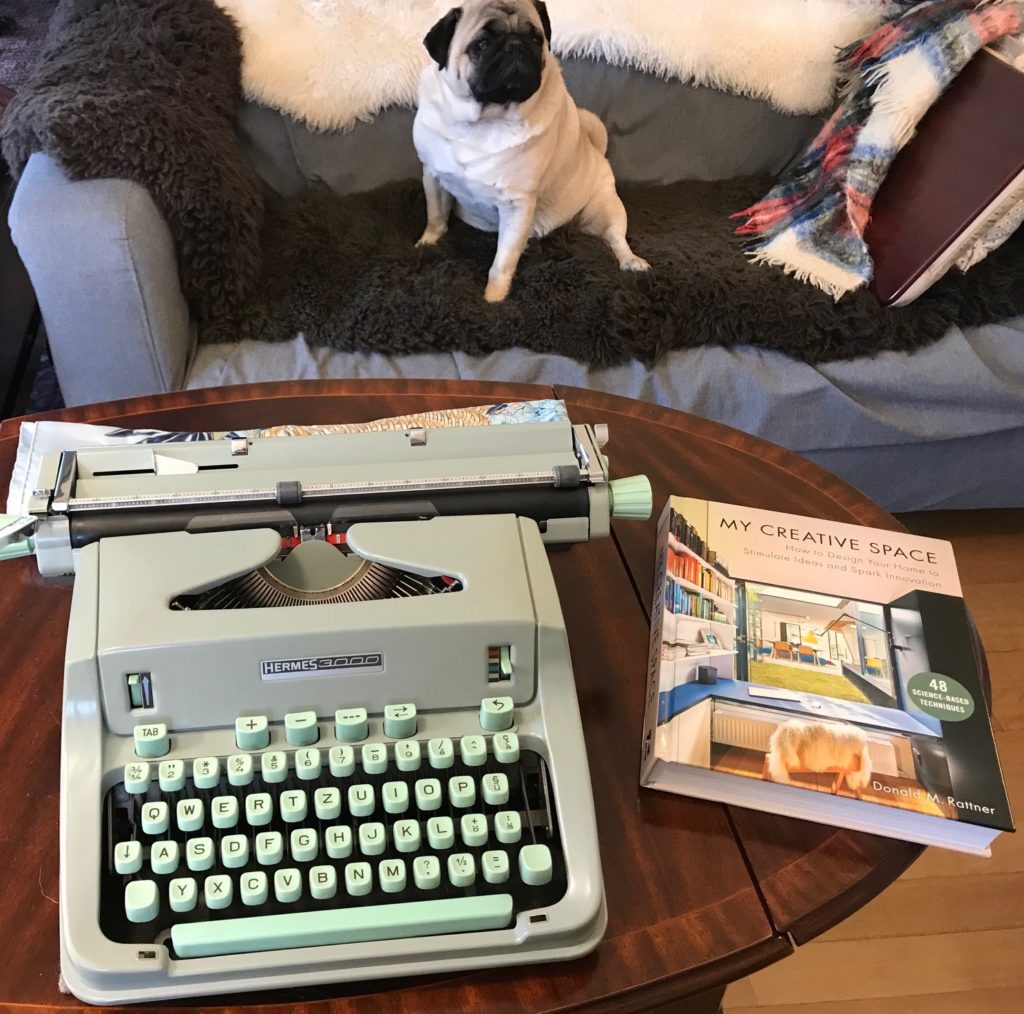
This blog posts on Mondays. Second Mondays of the month I devote to my writing workshop students and anyone else interested in creative writing. Welcome!
> For the archive of workshop posts click here.
Lo and behold, according to architect Donald M. Rattner’s My Creative Space: How to Design Your Home to Stimulate Ideas and Spark Innovation , which details 48 science-based techniques, I am doing more than a few things right in my creative space! And I learned a few things, too.
Pictured below, three birds with one stone, as it were, my writing assistant Uliberto Quetzalpugtl demonstrates Rattner’s science-based technique #25 “Sleep” and #26 “Nap” and #28 “Lie down or recline.”

#1 “Designate a creative space.” This winter 2020 my designated create space–I call it my office–is a room separated by a sliding door from the dining room. Plan B is my local coffee shop. In the past I have used a spare bedroom; a foyer (…that was challenging…); and a converted breakfast room. It is certainly possible to use a corner of the dining table; a breakfast table; a lap desk (taken to a sofa, chair, or bed); a table in a coffee shop; a carrel in a library… and so on. The point is, don’t be vague about where you’re going to do your writing. Designate it.
However, lovely as it may be for writer to have a large, totally private, and well-appointed office, it is by no means necessary. My advice would be, do your best to designate a creative space, whatever that best option may be for you at the moment, and then, get to the writing.
Yes, I find that does help, as Rattner says science confirms, to go to the same place each time you intend to write. But that isn’t necessary, either.
Here (below) my writing assistant models the big, sloppy Ikea sofa we use for lying down and, Rattner’s science-based technique #12 Choose curved over straight— the curved typing table; and #9 Be flexible–“Get the most creative bang for the buck by choosing furnishings and objects that move, change shape, or perform multiple functions”– note that the typing table has a drop-leaf, and note also, on the sofa under the plaid blanket, my lap desk. (Read more about the lap desk here.)
And my assistant also models #15 Get with your pet. “Studies indicate that having an animal friend nearby improves mood and mental dexterity.” (Uliberto Quetzalpugtl says, BARK BARK!)
“Studies indicate that having an animal friend nearby improves mood and mental dexterity.”
Here, below, Uliberto Quetzalpugtl models scientific technique #16 Make it beautiful. (Is my folded scarf used as the typewriter’s dust cover not beautiful?) And, simultaneously, #2 Look at something blue. Rattner writes: “Who would have thought that merely being exposed to certain colors could subliminally improve creative performance? Yet that’s precisely what researchers concluded after conducting several laboratory experiments measuring the impact of color on cognitive processing.”

More of Rattner’s techniques for sparking creativity that were new for me included:
#24 Pick up the scent— I’ll try rosemary or anise tea. (What might work for you?)
#29 Make a fire. Or look at a picture of one. I googled “YouTube virtual fireplace” and this came up:
Très eco-eco (economical & ecological)– if you don’t take into account the server farm!
In sum, I found this a fun and thought-provoking book, and I expect I’ll be going through it many a time again.
BUT A CAVEAT
While there is a wealth of practical and easily affordable advice to glean from Rattner’s book, don’t let the slick photos of high-end design intimidate you into accepting another reason to procrastinate. (My creative space doesn’t look like that, so…) No creative space is ever perfectly perfect, and indeed, some of the most wonderful literature we have was produced in godawful conditions.
If you want to have written something, you just have to sit down (or stand) and do the work. Last I checked, the Muse may whisper an idea or three, but magic elves don’t get it done for you in the wee hours of the morning. I would suggest that improving your creative space best goes into the category not of writing time but quality leisure time, the importance of which I and some others have more to say here.
P.S. If you’re starting the year with some writing resolutions, you might consider “Giant Golden Buddha” and 364 more 5 minute writing exercises. They’re free, help yourself.
Next post next Monday.

A Working Library: Further Notes and Tips
for Writers of Historical Fiction, Biography, History,
Travel Memoir / Essay, etc.
A Visit to El Paso’s “The Equestrian”
Five Techniques for a Journey to Einfühlung
Find out more about
C.M. Mayo’s books, articles, podcasts, and more.
.


